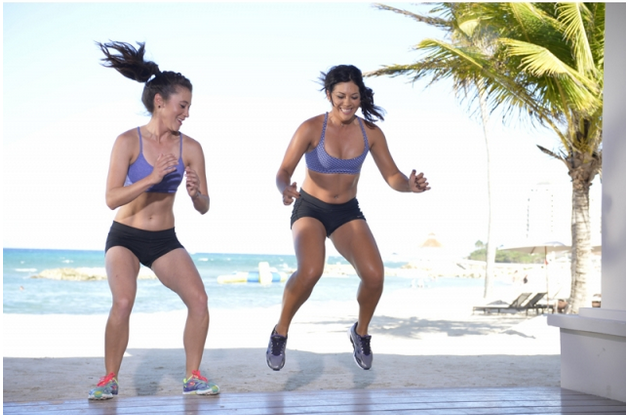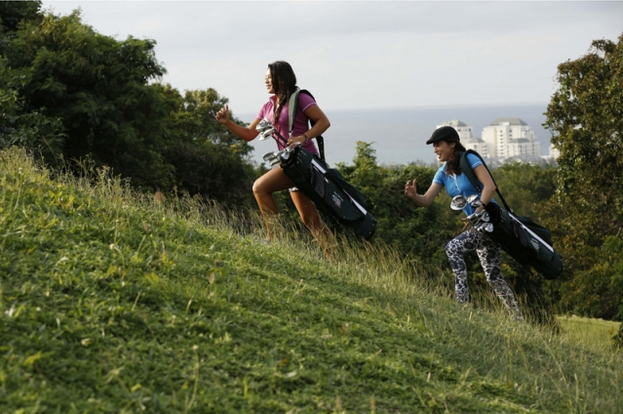The last time I caught up with Kelowna, B.C.’s Kyla Inaba, she was captain of the Thunderbirds golf team at the University of British Columbia and seriously considering a future in professional golf. Fast-forward a few years and the 28-year-old has not only made up her mind, she also made it onto Golf Channel’s latest reality competition, Altered Course.

Kyla was training for another season of Arizona-based mini tours with previous UBC teammate and close friend Eileen Kelly (Victoria, B.C.), when NBC sent out a casting call for an all-new reality concept.
Following 24 successful seasons of one of my favorite reality TV shows, Big Break, Golf Channel decided to create a new competition that combined speed, agility and strength with technical golf talent. The goal was to highlight the athleticism required by today’s top players and bring a new level of excitement to televised golf.
Kyla and Eileen, the self-titled “Canadian Ninjas” were the third eliminated team in what has proven to be a thrilling first season.
Another UBC alumni golfer and fellow blogger, Haley Cameron, caught up with the B.C. natives to learn how Altered Course has altered their perspectives on golf, fitness, and their professional futures. Check out her interview…
How did the two of you become selected for the inaugural season of Golf Channel’s Altered Course?
KYLA: It was no brainer to apply. We received an email from NBC Universal pitching a brand new show designed to ‘test your golf game, fitness level and ability to adapt to “re-imagined” golf holes that traverse multiple terrains.’ We thought, if this show isn’t perfect for us, we don’t know what is! Following a written application and video submission we were invited to a live audition in San Diego in early December, where we showed up in stereotypical Canadian toques. We got a call telling us we were shortlisted and a few weeks after that we got the final nod.
Could you briefly explain the format of the new reality show?
K: Altered Course is a combination of speed, golf, and altered holes. The holes were up to 900 yards in length and teams are required to play a variety of formats including alternate shot, scramble, and a 2-3 shot minimum. Many shots would be blind over trees into a check point or onto a green as teams raced against the clock to avoid additional penalty strokes.
How much did you know about the show and what would be expected of you going in?
K: As it was the very first season, we had no idea what we were doing until the first day of filming. We knew that it would include fitness and cardio with an emphasis on golf.
There were going to be eight teams in total and that we would be in Jamaica for two weeks! That was pretty well all they told us. But we also knew that this is something that we had trained for without ever even knowing.
EILEEN: Not knowing much ahead of time made training that much more intimidating.
What were the biggest lessons you learned competing in a speed/strategy golf event and playing for a television audience?
K: The longer you stayed in the competition the more you could perfect your strategy. Speed was critical but the number of strokes you took was most important. The show required a balance of being fast and being able to breathe over your next shot! While we were filming, it was just us and the camera crews—you don’t really clue in that millions of people will be watching in a few months’ time.
E: The biggest lesson I learned was how much I enjoyed being in high pressure situations. In this format you do not have any time to think, you can only react. Everything happens incredibly fast, which is not like normal golf. I now try to maintain this feeling when I am playing regular competition. I still try to be mindful and play smart, but to have less chatter in my brain.
Do you think a winning team from Altered Course would have a good shot at professional golf? Does this format prepare you well for traditional competition?
K: As Eileen said, this format puts “do or die” pressure on the competitor. You had no time to react to your shots; you just had to get to the next shot. So I found it interesting as a mental training tool.
E: Being able to execute shots under pressure when I could not breathe or feel my hands was reassuring. When I play any golf tournament, no matter the pressure, I will not have just run from however many hundred yards away! If I can hit a shot feeling that adrenaline, I can certainly hit it in front of a gallery.
K: Reality golf competitions are interesting because you are given one shot to complete a challenge. You don’t have 18 holes to pace yourself. It is more of a sprint, and in our case you could stumble once during the first challenge and have just one chance to redeem yourself in the elimination challenge.
E: Any team in this competition would have a good shot at professional golf if that is where their passion is. As you can see we are all very competitive, driven individuals.
K: Because of the nature of the show, not all of the competitors were aiming for a career in professional golf. There were a variety of careers represented from physiotherapist to American military.
What were some of the emotional and physical highs and lows of the season?
K: The first episode was full of excitement, nervous energy and exhilaration. In the second episode, when one of the teams lost in elimination and were sent home, everything got really real. It wasn’t just sunshine and lollipops anymore, it was emotional to see the Georgia Boys go home.
The third episode displayed quite the span of highs and lows as we took too many strokes and time, to say the least, in the first challenge. The hill running up to the check point was quite a doozy on my legs, and I really had to dig deep!
Making such a large number was obviously disappointing but we were relieved and excited for our second chance in the elimination challenge. We analyzed our performance before heading into the elimination challenge and focused on what we could do better.
Our elimination challenge in episode 3 was one of our highs and our lows as we played very solid golf, and played very quickly. We gave The Twins a really good run for their money and we gave the show drama as we posted a number for the Twins to beat. Leaving the show was more emotional than I thought it was going to be, as we just wanted to keep competing. We knew we could hang on the same level as the teams that had survived thus far.
What was your proudest moment on the show?
K: I thought Eileen’s pitch on episode 1 was one of the clutchest shots on that entire episode.
E: Coming back in elimination after we strategized and worked through what happened in the morning was a very proud moment. This show is about fitness, golf and teamwork. I think we were so focused on the first two and forgot that the third part is huge. Once we had a good talk, our performance improved tremendously. It was too bad we did not have more time in the competition because we would have been tough to beat.
What’s next?
K: I have played multiple tournaments this summer season including three state opens, a Symetra Tour event, and two Canadian Tour events. Next up is LPGA Qualifying in Palm Springs Aug 6-9.
E: I have and will continue to play in multiple state opens, Monday qualifiers and prep for playing on the Australian tour in January.
Thanks so much ladies for sharing your experience on the show and to Haley for taking the time during her travels throughout Europe to do the interview.
Tune in this Monday for the season finale to see which remaining team will win in the end and what this exciting altered layout is all about.
Golfgal
Photos courtesy of Golf Channel
 Golfgal Golf news and commentary from a business woman’s perspective.
Golfgal Golf news and commentary from a business woman’s perspective.










